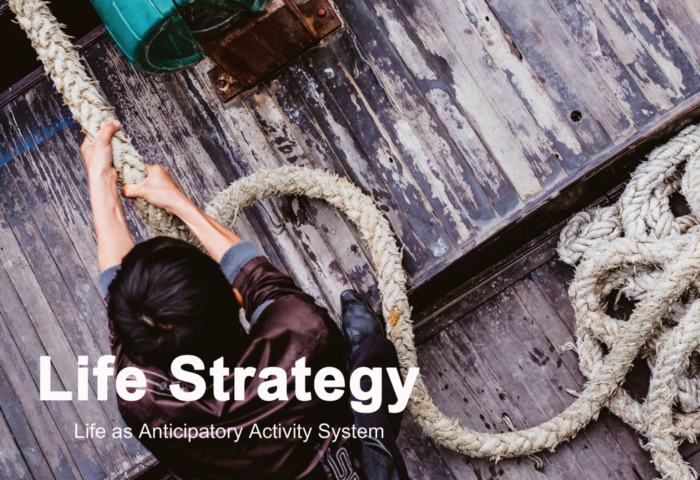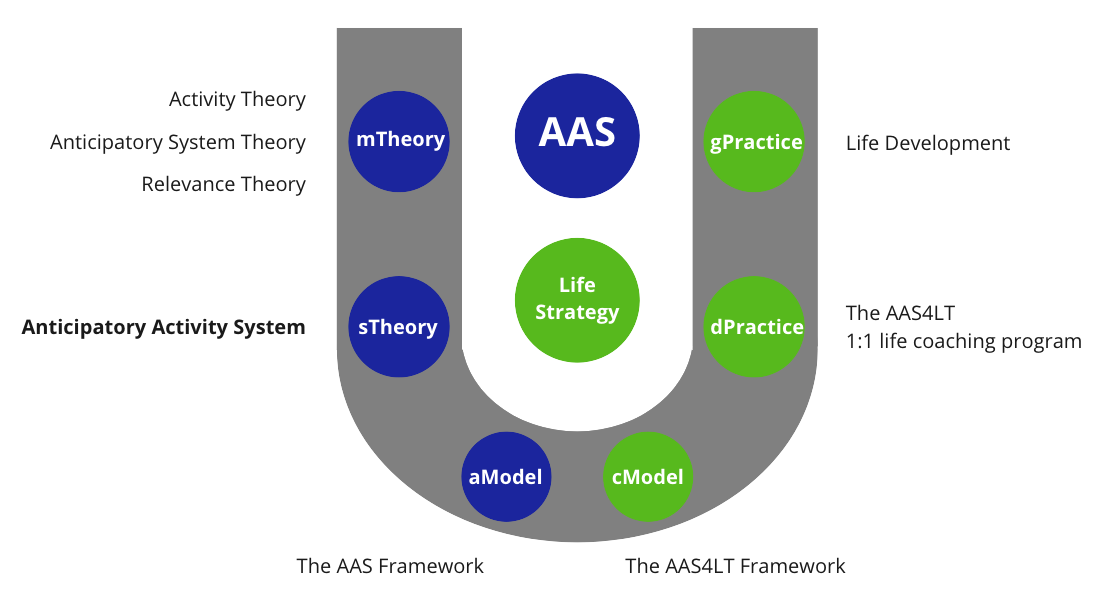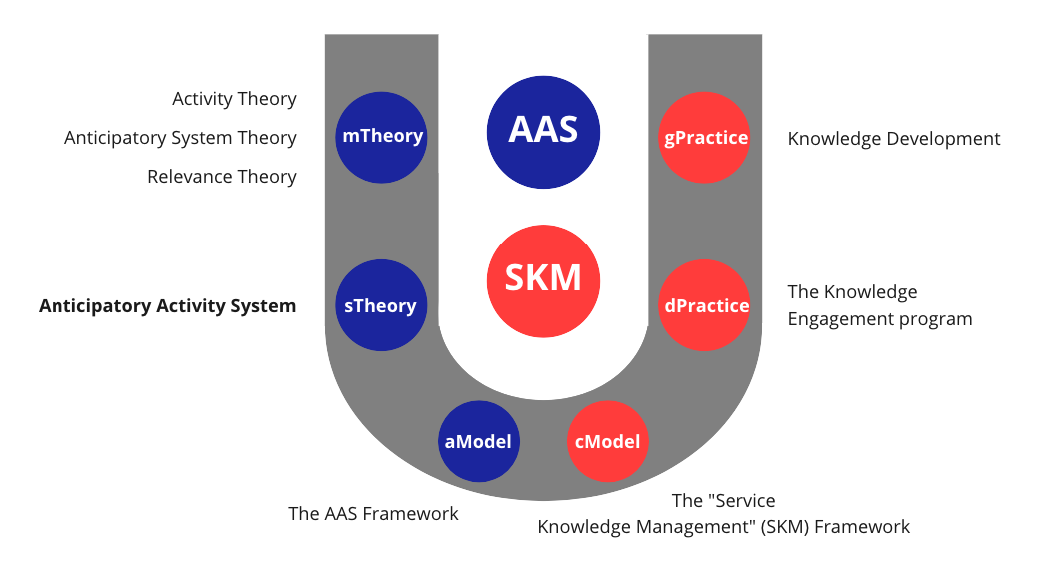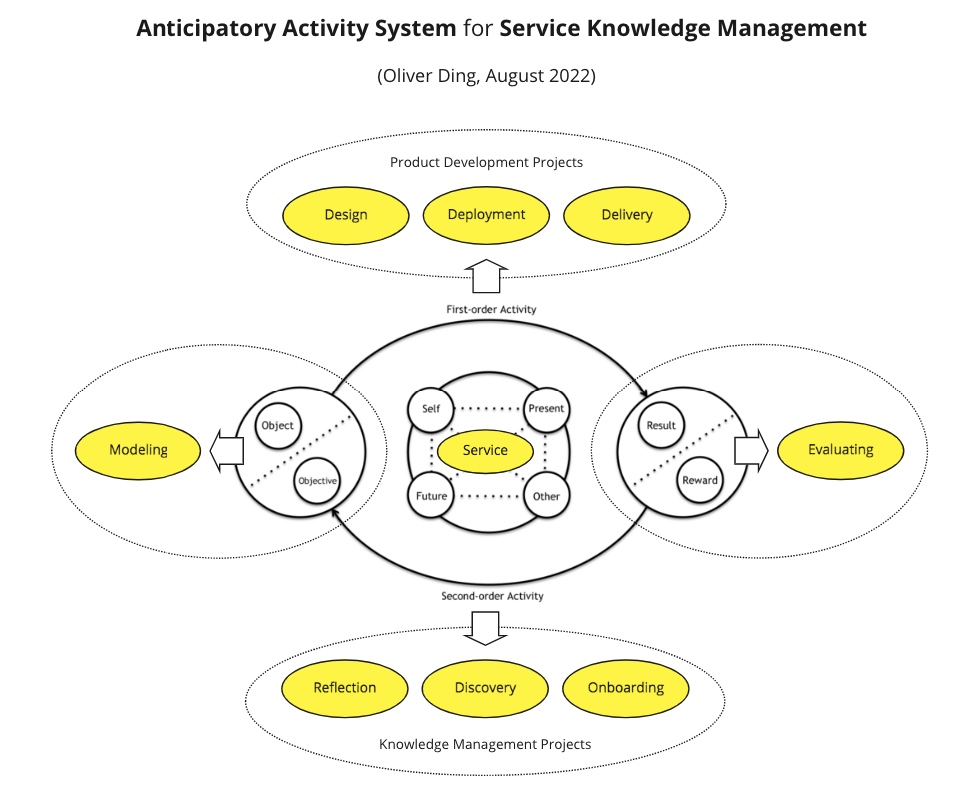The AAS framework for Life Strategy and Service Knowledge Management

"AAS" stands for "Anticipatory Activity System"
Yesterday I launched Life Strategy Center on Coda.

https://coda.io/@oliverding/the-life-strategy-center
The Life Strategy Center is guided by the Knowledge Curation approach. We are curating various theoretical resources to build new theoretical frameworks and applying these frameworks to develop new concepts, tools, programs, and environments.
One framework we are working on is called the Anticipatory Activity System (AAS) framework.
The attached diagram represents the knowledge curation approach.

Three blue dots refer to the THEORY side while three green dots refer to the PRACTICE side.
We work on the following four levels:
- sTheory: Specific Theory
- aModel: Abstract Model
- cModel: Concrete Model
- dPractice: Domain Practice
"Anticipatory Activity System" is a specific theory inspired by Activity Theory, Anticipatory System theory, Relevance theory, etc. It defines the basic model of the AAS framework:
- First-order Activity / Second-order Activity
- The Anticipation - Performance Complexity
- The Self-Other Relevance
The AAS framework is an abstract model which highlights five movements of Anticipatory Activity System.
- Unfolding
- Discovering
- Modeling
- Producing
- Storytelling / Evaluating
The #AAS4LT framework is an 8-step framework for applying AAS to Life Transitions (LT). It considers “Life Discovery Project” as Second-order Activity and “Life Developmental Project” as a First-order Activity. This is a concrete model.
At the domain practice level, I design and host the AAS4LT 1:1 life coaching program.
You can find more details on this page:
https://coda.io/@oliverding/the-life-strategy-center/the-framework-3
Service Knowledge Management
The other progress of the AAS framework is the "Service Knowledge Management" (SKM) framework which was born in July 2022.

In July 2022, I developed the Knowledge Engagement Program (v1) for a client. Though the program focuses on “Service Knowledge Management”, it can be considered as a general program for applying the Project Engagement approach to Knowledge Management.
You can find a public version of the program on Milanote.
The client’s activity is defined as “Service Knowledge Management” which is a special type of activity.
I adopt the “Anticipatory Activity System (AAS)” framework to understand “Service Knowledge Management”:
- First-order Activity: Software Product Development
- Second-order Activity: Service Knowledge Management
Why do we need to use the AAS framework? If we don’t understand the first-order activity, then we can’t understand the second-order activity.
The diagram below is the "Service Knowledge Management (SKM)" framework which is a concrete model.

I host the Knowledge Engagement Program on Milanote which is a digital whiteboard for creative curation. See the screenshot below.

The client’s activity is understood as an Anticipatory Activity System.
The Anticipatory Activity System (AAS) framework is developed for understanding “Self, Other, Present, and Future”. It is formed by First-order Activity, Second-order Activity, and the Self — Other Relevance.
- First-order Activity: Software Product Development
- Second-order Activity: Service Knowledge Management
- The Self — Other Relevance: Self refers to a service provider while Other refers to a client.
We will use the Activity System Model (The Engeström’s Triangle) for understanding First-order Activity and use the Relevance of Zone framework to understand the Self-Other Relevance.
First-order Activity
The client's production activity is Outsourcing Software Product Development which is based on a project-based workflow. Thus, we use "Product Development Projects" to name the First-order Activity.
We roughly identify three significant activities for the SKM framework.
- Design: how does a team work with a client on designing a software product?
- Deployment: how does a team develop codes for the software?
- Delivery: how does a team deliver the final product to the client?
Each activity is a collaborative activity. We can use Yrjö Engeström's Activity System Model to identify contradictions and best practices.

You can find more details in the Activity System Model and Activity System: Four levels of contradictions.
Second-order Activity
The client's knowledge activity is named Service Knowledge Management. We also use a project-based workflow to understand the activity.
We identify three significant types of Knowledge Management Projects:
- Onboarding
- Discovery
- Reflection
The Knowledge Onboarding project aims to set a framework and workflow for onboarding clients' knowledge about products, markets, strategies, etc.
The Knowledge Discovery project is about encouraging all team members to pay attention to developing their own Tacit Knowledge and sharing this knowledge with the team or the client.
The Knowledge Reflection project refers to project-based reflection.
Modeling/Evaluating Service
The SKM framework also considers two movements: modeling and evaluating.
We use the ECHO Way framework to develop a new framework called “Service-fit” to understand the "Self - Other" relevance of "Service Knowledge Management". See the screenshot below.

The Service-fit framework will be the guide of the whole program. We can use it to define sub-projects one by one.
By using the Theme U model, I identify three types of fit of “Service-fit”:
- Fit A = Knowledge Reflection
- Fit B = Knowledge Discovery
- Fit C = Knowledge Onboarding

The whole program starts with Knowledge Onboarding (Fit C) which is only about supporting Project-based workflow. Each project requires information from Clients in order to run the Software Development Activity. The outcome of Knowledge Onboarding is only useful for a particular project.
Since the Software Development Activity is a dynamic process, it will bring opportunities for Knowledge Discovery (Fit B). The outcome of Knowledge Discovery goes beyond a particular project but benefits the long-term workflow of the team and the whole company. Also, the outcome of Knowledge Discovery contributes to both Service Providers and Clients.
After closing a project, both Service Providers and Clients need to run the Knowledge Reflection (Fit A) in order to evaluate the outcome of the Knowledge Discovery Activity and preserve them. They need to pay attention to by-products, significant insights, challenges, problems, special internal tools, etc.
